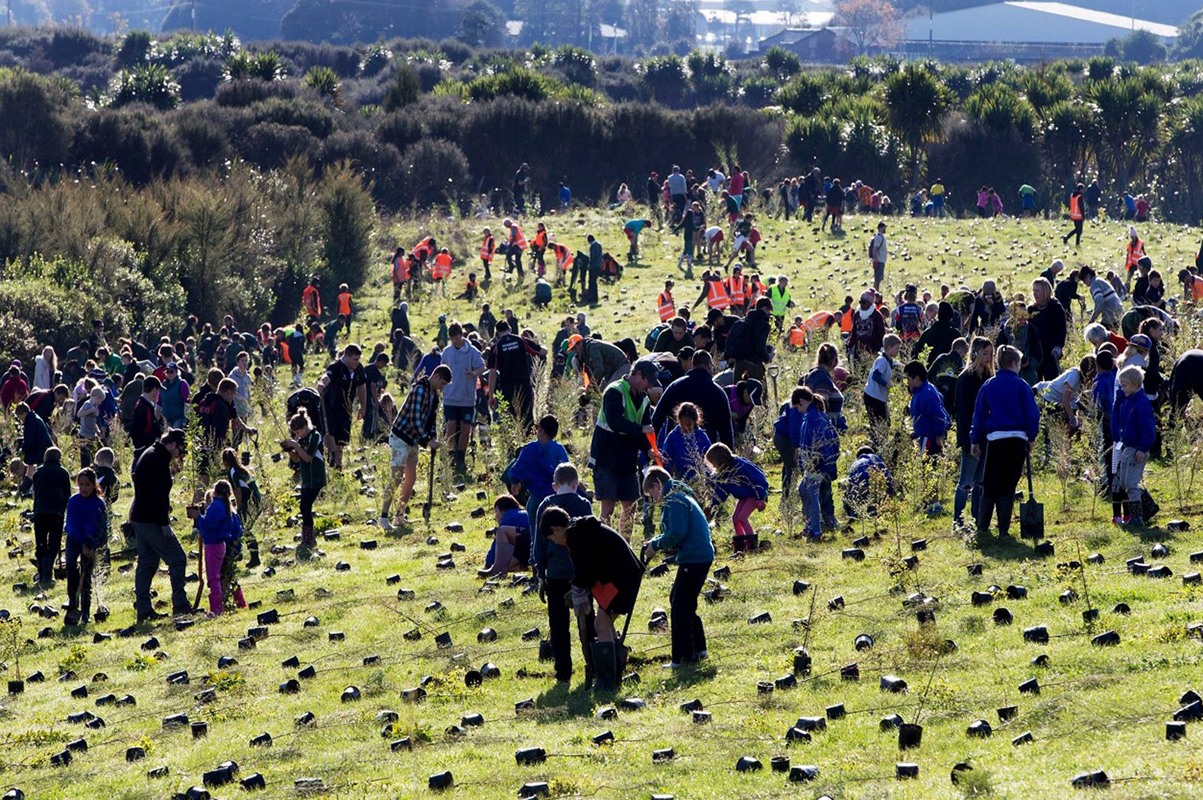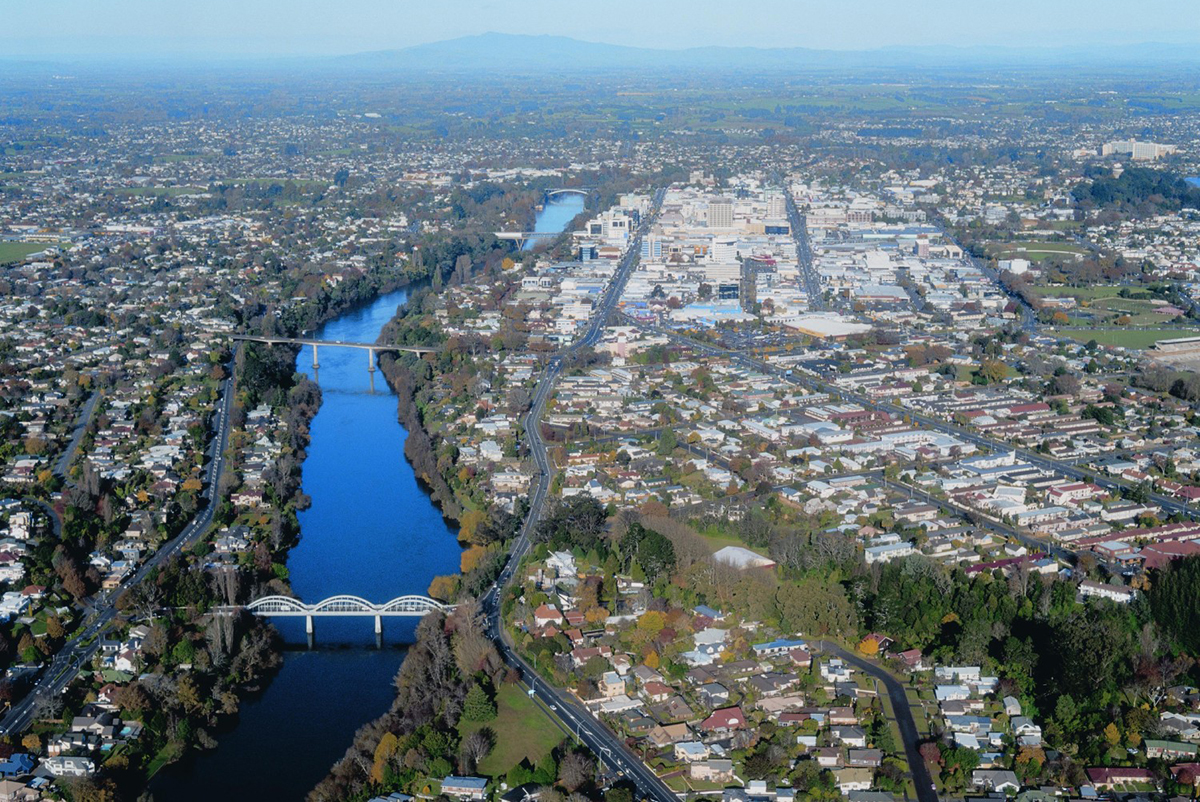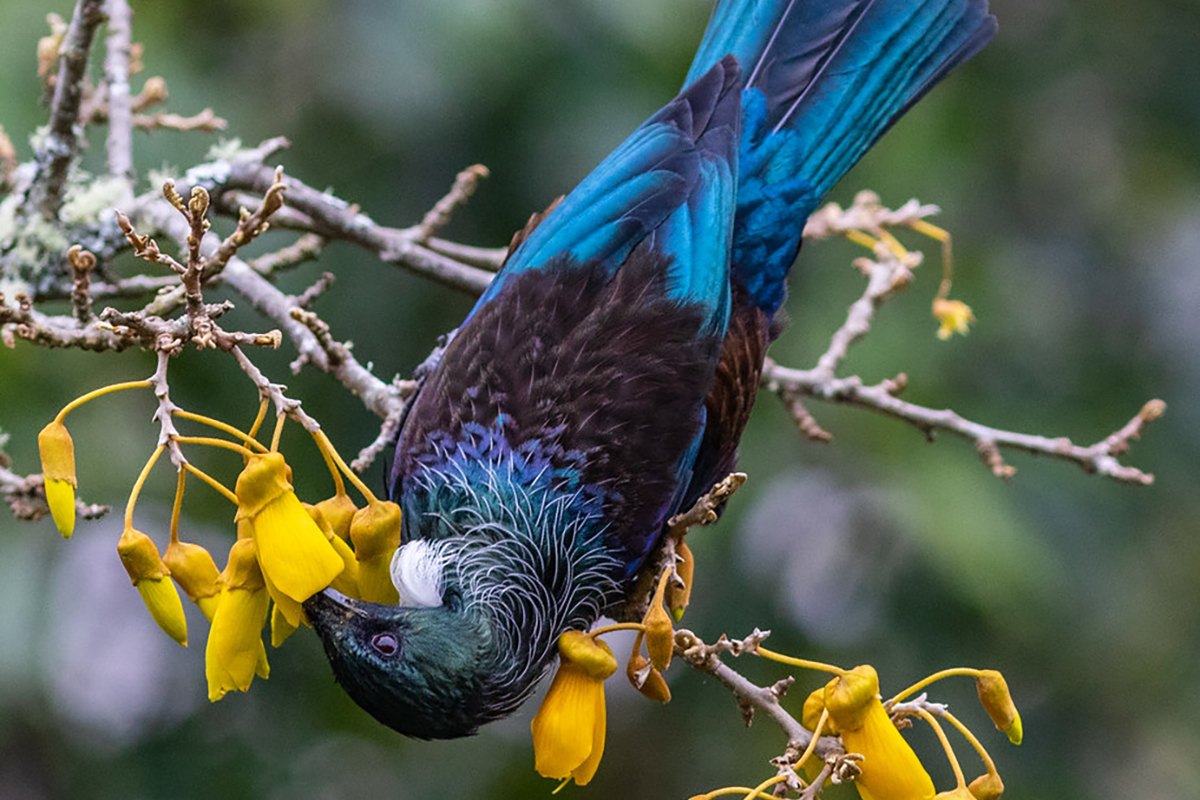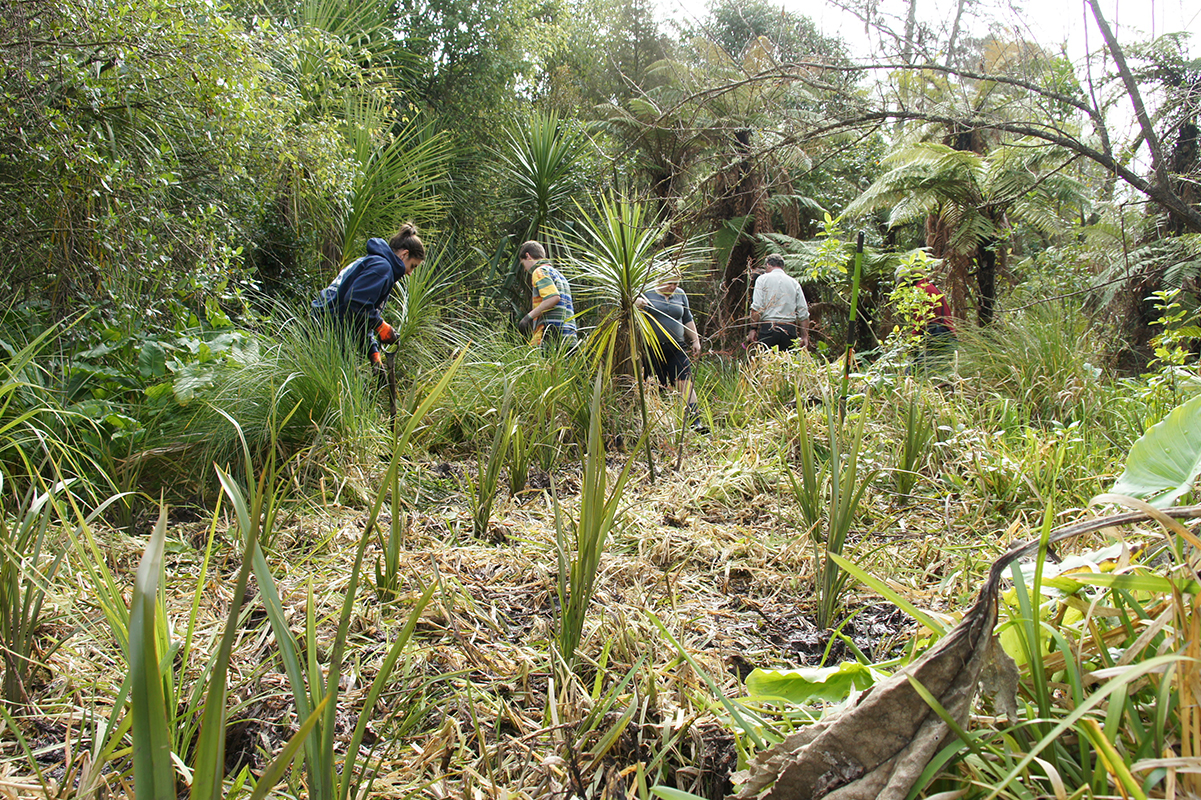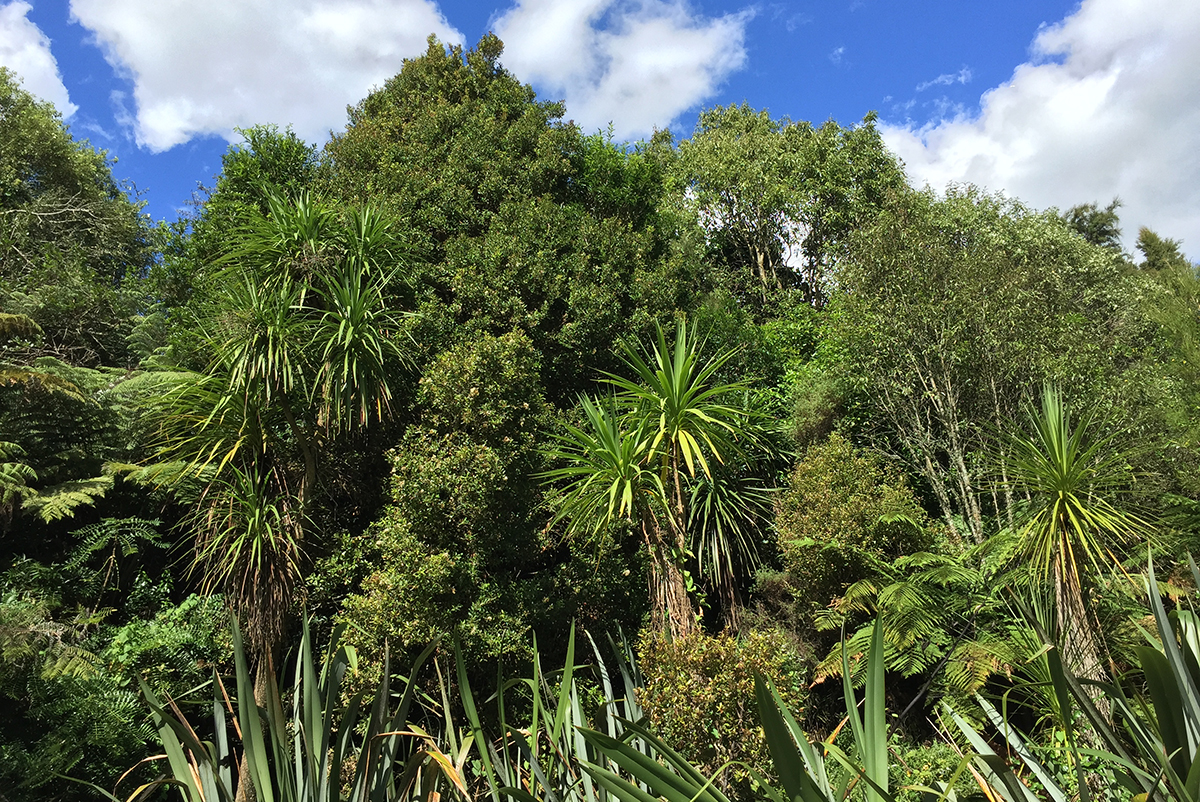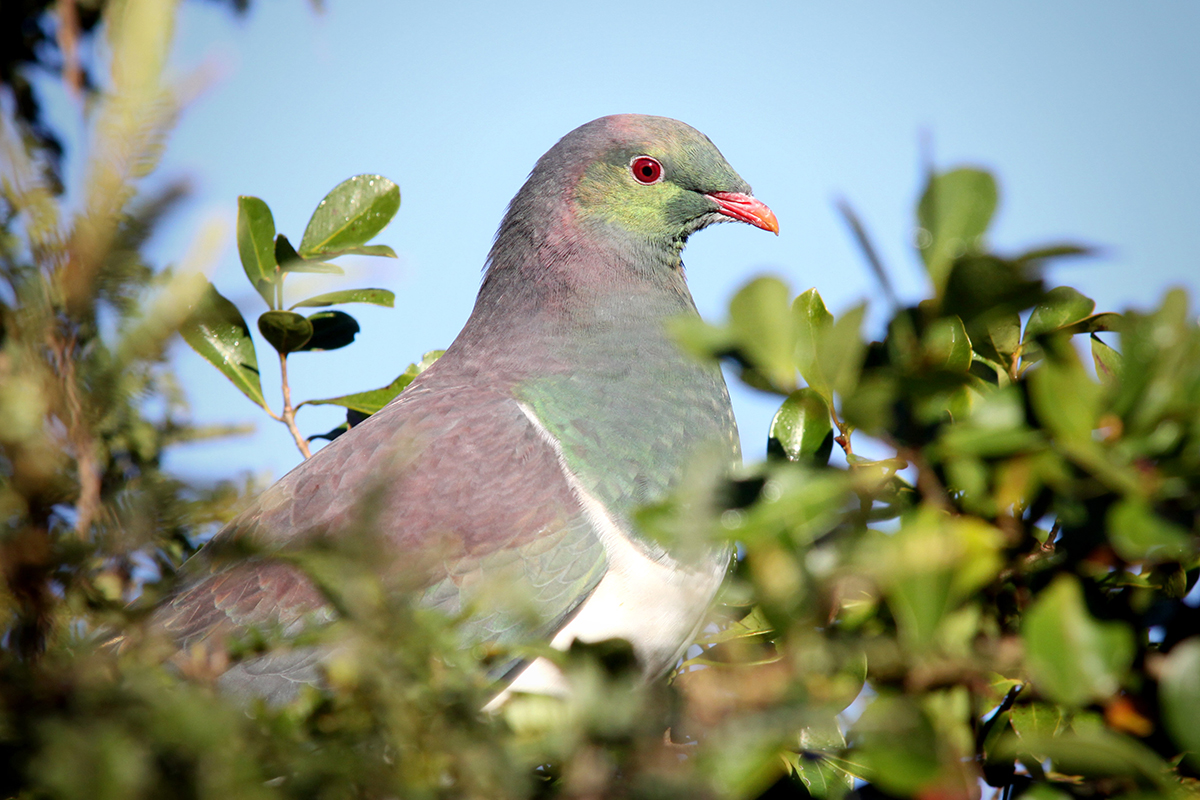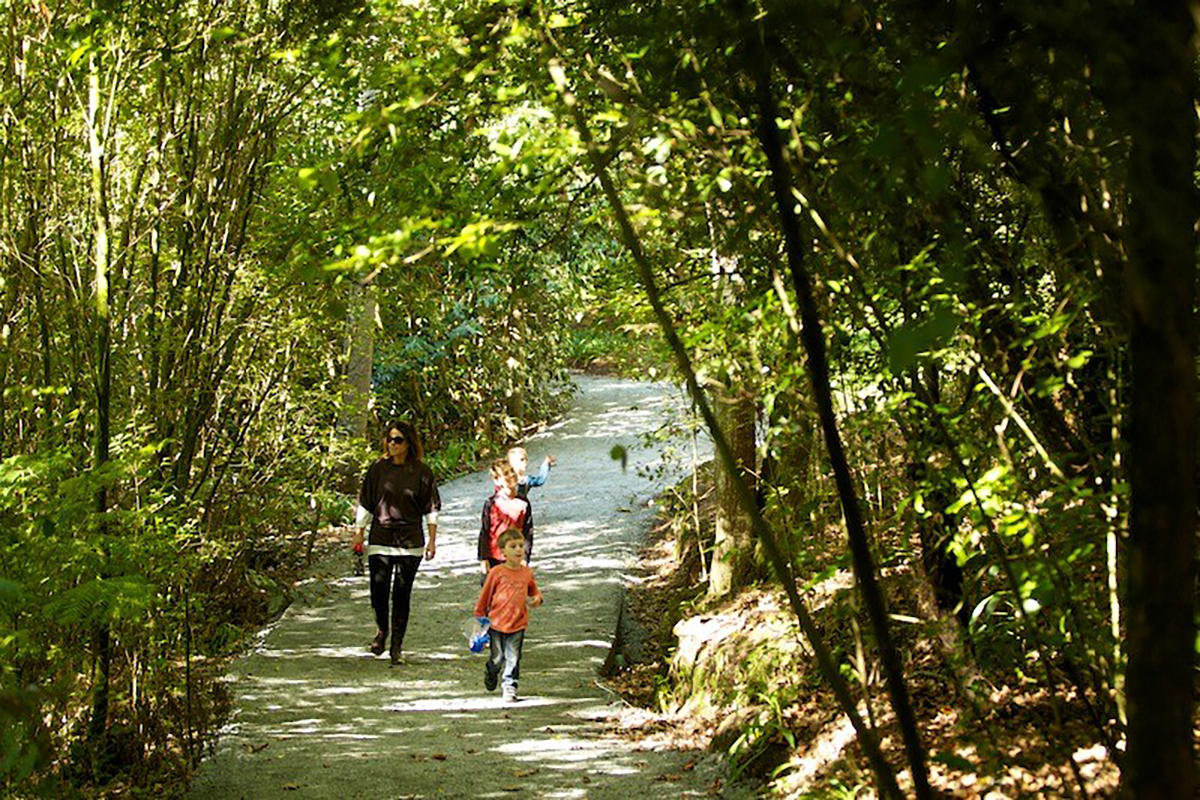Addressing the urban challenge
Breadth of the issue – How are the problem(s) that are being tackled by your initiative affecting citizens/local businesses or a significant component of the local wildlife?
As mentioned previously, Hamilton only has 1.8% native vegetation cover. For ecosystems to be resilient and sustainable over time, at least 10% native vegetation cover is required. Research indicates that the already limited ecosystem types in Hamilton are under threat of collapse and are compromised through lack of connections to the wider ecological landscape.
Therefore, the breadth of the issue is significant, both across the city and the broader regional ecological landscape. Restoring the remnant native forest areas in Hamilton – as well as enhancing and expanding them – ensures that these ecosystem types are represented within the city. This restoration is also important as these areas function as corridors and connections to neighbouring food sources and nesting locations – many of which vary across the seasons.
The ecosystem services – particularly regulation and provisioning services – which Hamilton’s vegetation provides, has a broad impact on both human and flora and fauna health. A lack of vegetation cover impacts negatively on-air quality and temperature regulation across Hamilton, water quality in streams, as well as creating severances across the ecological network which impacts on the movement of species.
Furthermore, the low level of native vegetation cover in Hamilton has an impact on biodiversity at a national and global scale. New Zealand has a high level of endemism, and this makes a global contribution to biodiversity. The lowland ecosystem types (which are often in areas most favoured for development) are significantly under-represented and therefore vital to restore.
Depth of the issue – How seriously are the problems being tackled by your initiative impacting the life of the citizens/businesses/wildlife concerned?
Given the current low percentage of native vegetation cover in Hamilton, there is a serious risk to entire ecosystems, individual species of flora and fauna and human health and wellbeing.
Hamilton’s biodiversity has a vital role in ensuring ecosystem representation across a regional landscape. Given the intensive urban development in Hamilton (particularly since the 1950s), the low-land ecosystem is especially vulnerable to further development. The sustainability of some of the threatened species present in these environments are at risk.
In addition to the impacts on the resiliency of ecological networks and connections and potential further loss of species, there is a significant impact on human health and wellbeing due to the current state of nature in Hamilton. Recent research has highlighted the negative impact of a lack of access to nature for urban-based populations. An increased reliance on technology and a growing disconnection with the natural world exacerbates the impact of ‘not getting enough nature’ on those who live in and visit Hamilton.
Furthermore, within a Maaori world view, the loss of species or vulnerable state of the environment impacts on the health and mana (pride) of people.
The power of plants and natural ecosystems to deliver benefits
How is the initiative shaped by scientific evidence of the potential for plants and natural ecosystems to deliver benefits?
Given the evolution of its physical environment and isolation from other land masses, New Zealand is home to a significant proportion of endemic indigenous species – found nowhere else on Earth. This includes:
• 72% of birds;
• 84% of vascular plants;
• 81% of insects;
• 88% of freshwater fishes; and
• 100% of reptiles, frogs, and bats.
Within this context, the scientific evidence indicates that restoring vegetation in Hamilton makes a valuable contribution to global biodiversity. For example, threatened species Swamp Maire (Syzygium maire), giant kokopu (Galaxias argenteus), black mudfish (Neochanna diversus) and long-tailed bats (Chalinolobus tuberculatus) are all endemic to New Zealand and present within habitats in Hamilton.
Council drew on scientific evidence of the ecosystem types historically present in Hamilton and the work required to recreate them in an urban setting. Professor Bruce Clarkson, based at the University of Waikato in Hamilton, is a world-renowned expert in urban ecological restoration. Professor Clarkson has received significant government funding since 2004 for long-term research projects in Hamilton and other New Zealand cities.
In addition to Western scientific evidence, Maaori (New Zealand’s indigenous population) environmental management concepts and knowledge shaped the initiative. Maatauranga Maaori (the body of knowledge originating from Maaori ancestors, including the Maaori world view and perspectives, Maaori creativity and cultural practices) was used to frame the strategy and implementation. This is discussed further in the following sections.
Evidence was also drawn from the social sciences regarding the positive impact of restoring native vegetation on human health and social cohesion and connection.
How has the city exploited the potential of plants and associated ecosystems to deliver more than one benefit?
Positioning restoring native vegetation as an investment rather than a cost was a deliberate tactic in the strategy’s development. While investment in restoration delivers biodiversity and ecological benefits, it also delivers across social, economic and cultural well-being dimensions.
Increasing native vegetation enhances regulating and habitat ecosystem services. Significant areas of vegetation reduce the urban heat island effect and improve air quality. Native vegetation provides food and shelter for birds and insects, while planting out gully systems provides shade for streams, which makes for stable water temperatures for aquatic species.
In terms of economic well-being, increasing native vegetation cover in the river and gully systems further enhances Hamilton’s river city reputation. This improves Hamilton’s recreational and nature tourism offering.
In recent years, the restoration economy has seen continuous expansion. Within Hamilton, this opportunity has been seized by local hapuu (Maaori sub-tribe) as a way to deliver multiple outcomes: through establishing an ecological restoration social enterprise, traditional environmental practices are part of their business model. Additionally, increasing both the paid and volunteer work of native restoration requires a range of support services and supplies from local businesses.
Increasing Hamilton’s native vegetation cover also has social benefits. For the individual, thriving urban forests provide spaces of rest and solace from busy urban life. For communities, working together on ecological restoration enhances relationships. For new migrants, caring for and connecting with nature helps to develop strong relationships to place – a vital aspect of enabling them to ‘take root’ in their new home.
Innovative and Collaborative Solution
How does the initiative show evidence of feasibility, including on-going financial and logistical support?
Funding for the next 10 years for strategy implementation is secured through Council’s 2021-31 Long-Term Plan. This includes capital funding to create access to areas for planting and undertake planting, as well as operational funding to maintain newly planted areas with pest plant and animal control and enrichment planting. Additionally, funding has been made available to increase staff capacity at Council to implement the strategy and support greater community efforts.
There is also significant endorsement and funding assistance – at a local, regional and nation level – for ecological restoration. Within the Waikato Region (within which Hamilton sits), there are a number of funders who have ecological restoration as their key focus. Many of these relate to improving water quality, with revegetating stream corridors being an important priority for action to achieve these improvements. As implementation progresses, it is expected that Council will seek to partner with these organisations to make progress on mutual goals and outcomes.
There is also considerable community support for restoring native vegetation in Hamilton. This is discussed in more detail below.
Research and restoration practice over the last 20 years shows that restoration is feasible; the main sticking point has been collective focus and funding. The strategy and implementation funding provides both.
In what ways is the initiative innovative?
The strategy engages people in the visceral aspects of thriving nature within Hamilton: the power of gazing at a mature stand of trees as they reach skyward; the calming effect of a cool, clear stream as it winds its way through an urban forest; the wonder of watching native birds feeding on the bounty of autumn berries; a child’s adventure of making a hut from fallen branches and ferns after a storm; the satisfaction of returning year after year to a community planting area and seeing the forest grow. This was the primary call to action to restore nature in Hamilton.
Traditionally, the case for restoring biodiversity has drawn heavily from the biological sciences to create the rationale for action. Namely, that we are experiencing a biodiversity crisis and that we must act now to address the crisis.
This approach does not resonate as a positive call to action. Furthermore, it does not address the value of a thriving natural environment to the spiritual and social health of an urban population. Within a New Zealand context, environmental management concepts from Te Ao Maaori (the Maaori world) are also absent in this traditional approach.
While Hamilton’s key problem is the lack of native vegetation cover and the associated negative biodiversity impacts, the strategy focused on the power of plants for well-being. This was a deliberate re-positioning of the call to action: we need biodiversity because it makes us happier, healthier and more connected to each other and the environment around us.
How is the initiative supported by collaborative working across disciplines and sectors?
The strategy draws from collaboration with researchers, local Maaori and a range of disciplines to create the case for change. The biological sciences provide evidence of the historical loss, and current state, of Hamilton’s biodiversity. Council capitalised on an established working relationship with Professor Bruce Clarkson to provide guidance of the restoration of species required to recreate resilient ecosystems.
The social sciences (including anthropology, cultural geography, the health sciences and psychology), climate change research and traditional Maaori knowledge were also used to spell out the importance of restoring native vegetation within Hamilton.
The strategy, implementation and monitoring incorporates Maaori concepts of kaitiakitanga (care and stewardship of nature) and maatauranga Maaori (traditional Maaori knowledge). In recent years, collaboration between researchers in the biological sciences in New Zealand and those in indigenous studies have seen Maaori environmental management concepts used to improve ecological restoration. This research area – and the new knowledge it creates – is unique to New Zealand. Council collaboration with local Maaori is also an important part of the strategy’s implementation and monitoring.
Within Council, the strategy provides the impetus for embedding ecological restoration across a range of Council infrastructure – particularly transport and stormwater networks. As a result of clear strategic direction, Council staff responsible for ‘hard’ infrastructure are seeing opportunities to deliver on social, environmental, economic and cultural wellbeings through weaving green and blue infrastructure (forest and aquatic networks) with grey (transport). It is intended that the implementation of the strategy will further capitalise on these opportunities
How does the initiative demonstrate evidence of community support?
Community support for restoring Hamilton’s native vegetation is robust. There are a number of individual property owners and restoration groups currently undertaking replanting in gullies and other restoration sites within Hamilton. This community support was a critical factor in developing the strategy and gave Council the confidence to approve implementation funding.
Many of these individuals and groups view the unique geography – the river and gully system – within Hamilton as an important natural resource for biodiversity improvements, human health and social cohesion. For example, there is considerable community support for, and ownership of, Waiwhakareke Natural Heritage Park. Since its inception in 2004, the project has held several planting days a year. These are popular with Hamilton residents, who bolster the native plant numbers ‘in the ground’ by the thousand.
There are over 13 ecological restoration groups operating in Hamilton’s gully systems. These groups are powered by volunteers who dedicate hundreds of hours annually applying for funding, undertaking planting, working with individual landowners and running educational events. These groups have told Council there is a wealth of additional community interest in restoration work and that resourcing for plants and equipment would help them to realise this potential interest.
The community engagement undertaken during the development of the strategy echoed this sentiment, indicating that Hamiltonians wanted more opportunities for involvement in ecological restoration. The implementation funding has an education and engagement component to it which will assist in providing people with tangible avenues for involvement in local ecological restoration.
Implementation, Impact and Replicability
How does the initiative demonstrate evidence of a track record of success against pursued objectives?
As mentioned above, the impact of Covid restrictions has impacted the scale of progress able to be made. The timing of strategy adoption and approval of long-term funding was also a factor.
Despite these factors, Council has prioritised two gully systems (Kukutaaruhe and Te Awa o Katipaki) within Hamilton as sites for restoration planting to begin ‘on the ground’ implementation. Plant and animal pest control, design for access infrastructure (in the form of access paths and boardwalks) and planting plans are currently taking place in order to complete planting in the autumn and winter months (May to August).
One of the early successes of the adoption of the strategy and implementation funding is a refreshed enthusiasm for ecological restoration in Hamilton. This has come from both those already involved in restoring nature and those who have been wanting to get involved. Given that community capacity building will be part of the strategy implementation, this community enthusiasm will be able to be harnessed.
Council has established relationships with community restoration groups and local Maaori restoration groups. These relationships have been developed over the last 20 years. The adoption of the strategy and implementation funding has strengthened these relationships and bolstered the commitment to work together. It is expected that the strength of these relationships – and their breadth across the city – will continue to grow as the strategy is implemented.
How has the initiative had a ripple effect beyond the scope of the initiative itself, thereby demonstrating a change in the city’s and/or its partners’ way of working with plants?
Despite Covid impacting the scale of progress, the initiative has made some positive in-roads both within Council and external agencies and organisations.
Positive reputational impacts have already been made. The initiative cements Hamilton as a city which is embarking on transformational change in ecological restoration, healthy urban environments and connected communities. It positions Hamilton as an active participant in the restoration economy, which will likely result in other agencies and businesses – whether it be research or philanthropic organisations or Maaori across New Zealand – seeking out partnerships. This can only be of mutual benefit to all involved.
There has been an instant positive ripple effect of increasing capacity of staff with ecological expertise. Council staff currently involved in maintaining and developing Hamilton’s open space network have excellent knowledge across a wide range of areas in caring for parks and reserves. However, on-boarding additional staff with ecological expertise has already assisted staff to deepen their understanding of native plant knowledge. Over time, this knowledge will enable staff to contribute to Hamilton’s native vegetation at an increased scale.
There is growing interest from Council staff to contribute to progressing the strategy. In particular, staff from Council’s Transportation, Three Waters (water supply, stormwater and wastewater) and Growth (urban development) Units are collaborating with staff who have ecological expertise to ensure that native green space is a core project consideration. The Growth Unit is improving collaboration with developers to ensure ecological networks are incorporated at design stage for new urban areas.
How have other cities expressed interest in the initiative, or what potential does it have to interest other cities and be customised to their own circumstances?
To date, Council has had limited opportunity to promote the strategy to other cities, either in New Zealand or internationally. However, the principles used to develop the strategy have potential use to cities embarking on developing their own green city strategies.
A range of social, environmental, cultural and economic evidence was interpreted through the lens of Hamilton’s demographics and unique geography during the strategy’s development. The principle-based approach to strategy development and implementation funding which focuses on the specific geography, people and knowledge of the area has great potential for other cities. In Hamilton’s context, it resulted in the Waikato River and gully being a primary focus for restoration. This nuanced approach to native vegetation restoration is likely to be of use to other cities in developing their own tailored ecological restoration approaches.
Embedding a bi-cultural approach to ecological restoration in Hamilton, where Western science and Maatauranga Maaori (traditional Maaori knowledge) is used, was another principle used in the strategy development. Maatauranga Maaori is unique – no other country in the world has Maaori as their indigenous population.
While the bi-cultural lens will be of most use to New Zealand cities, the principle will also be beneficial to cities internationally. Although specific indigenous or First Nations knowledge varies considerably, collaboration which captures the richness of both traditional and contemporary knowledge is likely to result in a bespoke solution which will have a broad appeal to the community – regardless of the location.
Sustainability and Resilience
What efforts have been made to reduce the carbon footprint of the initiative?
Climate change mitigation and adaptation is a central tenet of the strategy and implementation funding. Increasing the percentage of native vegetation cover in Hamilton will assist in decreasing Council’s carbon footprint.
More detail of climate change considerations is provided in the following sections.
How have the anticipated impacts of climate change been considered?
Addressing climate change impacts (both mitigation and adaptation) was considered across all elements of strategy development. The strategy highlighted the climate change mitigation and adaptation benefits of increasing native vegetation cover to 10% in Hamilton by 2050.
In terms of the more extreme rainfall events which are likely to occur, having well-vegetated gully systems in Hamilton will decrease water velocity and protect against soil erosion from higher volume rainfall events. Forested stream banks will also act as a contaminant filter from stormwater runoff from impervious surfaces (such as roads and buildings). Addressing the anticipated impacts of climate change on rainfall and stormwater speed and volume through increasing ecological restoration strengthened the ‘river and gully’ implementation priority.
With higher summer temperatures predicted, research indicates that a city with significant forest cover reduces the urban heat island effect. This will have a positive impact on Hamilton’s liveability.
As stated previously, connecting with and caring for nature positively effects people’s health and wellbeing. Restoring ecosystems may assist in easing eco-anxiety (stress induced by the state of the environment) as it is practical, tangible action on climate change.
Climate change is addressed primarily through the strategy’s implementation. For example, Council has an extensive nursery, and in the last two years significant efforts have been put in ensuring appropriate plant selection for ecological restoration. Seeds have been eco-sourced from the surrounding ecological district which ensures they are adapted to the local micro-climate. Local eco-sourcing also minimises the carbon footprint associated with seed store transportation.
What processes does the initiative include for it to be considerate in its use of soils and other natural resources?
The primary focus of restoring native vegetation within the Waikato River and gully systems ensures that soil and water resources are enhanced. Restoring the banks of the deeply incised gully systems assists in Hamilton in maintaining bank stability and reducing soil loss. In time, the revegetated gully banks will slow the velocity of water during rain events and reduce soil loss into the streams. This will have positive effects on aquatic biodiversity. The revegetation of the six main gully systems in Hamilton also assists in reducing water loss through providing shade in the streams and lowering the stream water temperature.
As mentioned previously, restoration planting is done in the winter months. This largely negates the need to use potable water for plant survival in the summer months.
In terms of the protection and continuation of the biodiversity, which is present within the Hamilton Ecological District, seed material is locally sourced from forested areas of existing native vegetation in Hamilton and surrounding areas. The majority of seed material is then germinated and grown at Council’s plant nursery. The majority of the seed raising mix is made on-site at Council’s plant nursery from compost and plant material generated across Council’s parks and gardens network.
The community nurseries also follow a similar practice of eco-sourcing germinating and growing seed locally.
Monitoring, Maintenance, and Management
How has the initiative been designed and implemented so that long-term needs for management and maintenance are reduced and can be met?
The strategy takes a long-term view to restoring nature in Hamilton. The strategy’s 30-year horizon recognises that moving from 1.8% to 10% native vegetation cover will take decades.
Given the fragmented nature of ecological networks in Hamilton, pest plant incursion at the edges of small forest areas has impacted on their resiliency. Therefore, the implementation focuses on ‘stitching’ the gullies and river system together into a continuous ecological network and linking it to existing forest fragments (such as Te Papanui, a 5.2 hectare fragment of semi-swamp lowland forest) and significant urban restoration projects (such as Waiwhakareke Natural Heritage Park) to create a resilient, sustainable ecosystem.
The planting plans for the six main gully systems take a ‘right plant, right place’ approach. The planting programme phasing ensures the majority of planting occurs during the cooler, wetter (May to August) months, which enables the plants’ roots to be well-established before the summer heat. The ecological restoration groups in Hamilton have excellent knowledge about planting appropriate species and in the right season to ensure survival.
The first three years of planting requires establishment maintenance and replacement and enrichment planting to assist with succession.
Research indicates it takes 20 years for an urban forest restoration planting to achieve forest canopy closure. Following canopy closure, humidity and soil temperatures stabilise, and the forest then develops naturally through the other successional stages. By this stage, maintenance budgets are significantly reduced.
What protocols are in place to facilitate monitoring of results?
To date, the strategy is in the initial stages of implementation. The strategy was adopted in December 2020, and long-term implementation funding began on 1 July 2021. New Zealand was under a range of Covid restrictions throughout 2021.
As Council manages a number of community facilities and services (including a zoo, aquatic facilities, libraries, a museum and sports grounds), staff were required to reprioritise existing work programmes in order to meet Covid restrictions. Some of these restrictions required an immediate response from staff across the organisation to temporarily close facilities and services. These restrictions have impacted on various aspects of the strategy’s implementation.
However, positive progress has been made. Since securing funding through Council’s 2021-2031 Long-Term Plan, Council has increased its staff capacity in order to implement the strategy. Council has established a staff governance board (which also includes external partners) which meets regularly. The governance board ensures the implementation is tracking in line with the strategy’s vision, goal and outcome areas.
Council is also in the process of bringing together a cross-agency technical advisory group. This group comprises experts in ecological, cultural, social and economic sectors to ensure that programme is delivered to progress multiple outcomes. This group will develop a monitoring programme which will ensure that protocols are in place for programme delivery. The monitoring programme will use a range of established biodiversity measures (including those shaped by Western science and maatauranga Maaori), as well as measures which track social cohesion and human health.
How has the initiative been enhanced in response to monitoring of results?
As mentioned in the Implementation section, the timing of the adoption of the strategy, approval of the implementation funding and the impact of the Covid restrictions in New Zealand have impacted on the scale of progress Council had anticipated.
At this stage, the initiative has not had enough time to undertake monitoring and reflect on any required enhancements. Council is confident that the cross-agency technical advisory group (as mentioned in the Implementation section), with its focus across environmental, social, economic and cultural wellbeing dimensions, will ensure that the implementation funding delivers multiple benefits. It is anticipated that by early 2023, monitoring of the establishment phase of the implementation by the technical advisory group will yield useful information to make any enhancements to the programme.

















